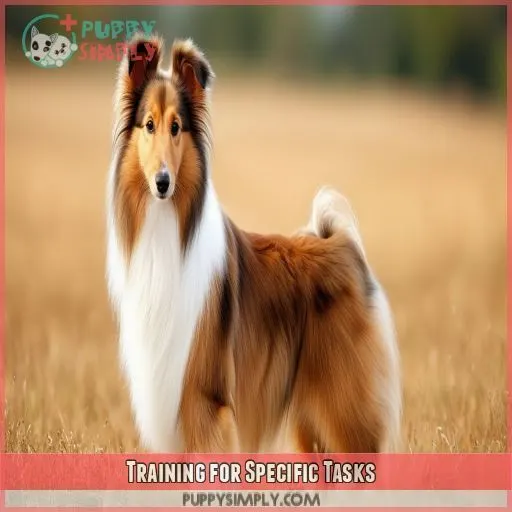This site is supported by our readers. We may earn a commission, at no cost to you, if you purchase through links.
 While the choice between a male or female Shetland Sheepdog for ease of training might be considered challenging, they do have particular differences. All are intelligent and love to please, but males may be more assertive in nature, while females can, at times, be responsive and focused.
While the choice between a male or female Shetland Sheepdog for ease of training might be considered challenging, they do have particular differences. All are intelligent and love to please, but males may be more assertive in nature, while females can, at times, be responsive and focused.
After all, success in training lies in individual personality and early socialization. So, in this article, an evaluation of obedience, responsiveness, and motivation in both male and female Shetland Sheepdogs aims to help you make an informed decision for your next companion
Table Of Contents
- Key Takeaways
- Are Male or Female Shetland Sheepdogs Easier to Train?
- Trainability of Male Vs. Female Shetland Sheepdogs
- Factors Affecting Training Difficulty
- Socialization and Training Importance
- Typical Training Challenges
- Training Methods for Shetland Sheepdogs
- Shetland Sheepdog Intelligence
- Differences in Training Motivation
- Influence of Sex on Training Outcomes
- Training for Specific Tasks
- Owner Commitment and Training Success
- Frequently Asked Questions (FAQs)
- Should I get a male or female Sheltie?
- Are male or female dogs easier to train?
- Are Shetland Sheepdogs hard to train?
- Are male or female dogs calmer?
- Are Shetland Sheepdogs intelligent?
- Are Shetland Sheepdogs easy to train?
- Are Shetland Sheepdogs aloof?
- Are Shetland Sheepdogs good guard dogs?
- How do Shelties behave in noisy environments?
- What are common health problems in Shelties?
- How much grooming do Shelties require?
- What diet is best for Shelties?
- How much exercise do Shelties need daily?
- Conclusion
Key Takeaways
Choosing a male or female Shetland Sheepdog for ease of training can be like navigating a maze, but knowing their distinct personalities can help you find your way. Male Shelties are often more eager to please and trainable, but they can also be more assertive. Female Shelties may be less immediately responsive, but they tend to be more focused and less easily distracted. Ultimately, the best way to determine which gender is easier to train is to meet individual dogs and observe their temperaments
Are Male or Female Shetland Sheepdogs Easier to Train?
When one considers whether male or female Shetland Sheepdogs are more accessible to train, it almost comes down to the differences in willingness to please. Male Shelties are more consistently dutiful and attentive to commands; hence, they are much easier to train for most owners. They thrive on positive reinforcement and often respond well to play rewards.
On the other hand, females can be independent and not quite immediately responsive, which can make training challenging. Both males and females can be very well-trained if done right. Want the full scoop on how to achieve training success with your Sheltie? Keep going!
Trainability of Male Vs. Female Shetland Sheepdogs
Male Shetland Sheepdogs try much more challenging to please and are more willing to obey than females. They also have a better response to training, hence making the process easier.
Obedience
Where obedience is concerned, it has been claimed that male Shetland Sheepdogs are more accessible to train than females. Generally, they listen better, and they’ve a willingness to obey without stubbornness or aggressiveness, as with some females. Proper socialization and constant training are crucial for developing dependable obedience traits in both sexes.
Eagerness to Please
Both sexes of the Shetland Sheepdogs, more familiarly known as Shelties, demonstrate the desire to please. Generally speaking, males are more consistent in their eagerness to please during training because they inherit intelligence and herding characteristics.
The females are usually more independent, sometimes making them less immediately responsive. Effective training techniques should capitalize on the strengths of both genders if positive puppy development and successful results are to be achieved
Responsiveness
While training a Shetland Sheepdog, males are more likely to be responsive than females. This is so because this breed seems to have a disposition whereby males train faster than females. Here are three key points:
- Temperature: The males are more willing to follow generally.
- Affection: Playfulness is one way males can be responsive.
- Training: Routine helps men thrive, and consistency is critical.
Factors Affecting Training Difficulty
Training difficulty in Shetland Sheepdogs can be influenced by breed characteristics, individual personality, and owner experience. Understanding these factors helps you tailor your approach for better training outcomes
Breed Characteristics
The temperament and breed characteristics of Shetland Sheepdogs have much to do with training. Known for being intelligent and willing to please, they respond very well to reward-based obedience. Their small stature, about 13 to 16 inches in height, makes the sheepdog less cumbersome to handle.
Male Shelties are known to show more affection in their playful way, and they possibly may be more stubborn; hence, well-defined and coherent training methods must be adopted. Usually, those working dogs work best for committed and patient trainers
Individual Personality
Every Shetland Sheepdog has a unique personality, influencing training outcomes. Individual temperament plays a significant role:
- Confidence: Confident dogs are easier to train and less likely to shy away.
- Motivation: Some dogs are food-driven, while others prefer praise.
- Socialization: Early socialization fosters adaptability, reducing fearfulness and improving learning.
Personality traits vary between males and females, impacting training success
Owner Experience
Experience with other dogs is an essential factor in the Sheltie’s training. The breed idiosyncrasies, such as male grooming or female fastidiousness, might be hard to handle for a new trainer. Trainers who are experienced won’t have any problem dealing with this breed’s temperament—variations in health like hypothyroidism, eye problems, coat care, and genetic conditions—on which their training and health management heavily rely.
| Owners | Expertise Level |
|---|---|
| Novices | Basic Knowledge |
| Intermediates | Growing skills |
| Experienced | Mastery level |
| Seniors | Expert Handling |
| Professionals | Expertise in specialized training |
Socialization and Training Importance
Socialization early in Shetland Sheepdogs’ lives is invaluable if they grow up to have good behavior around people and other animals, at the time of training, consistency and positive reinforcement help to nail down desired behaviors for more effective learning.
Early Socialization
A Shetland Sheepdog needs early socialization. First, puppy classes put a strong emphasis on training consistency. Breeders looking for a family pet should value temperament testing. Introduce your puppy to the small children and active families so he can get accustomed to them. These "shadow dogs" do well only when integrated into family routines smoothly.
Positive Reinforcement
Positive reinforcement is a must when training Shetland Sheepdogs. Using rewards like treats, praise, or play helps embed positive behaviors. Highlighting differences between genders, males may respond more to play rewards, reflecting their breed’s lively nature.
- Use high-value treats
- Provide verbal praise
- Incorporate favorite toys
- Utilize clicker training
Consistency
Training of Shetland Sheepdogs would be impossible to expedite if one didn’t consider gender differences and temperamental variables.
Regular routines allow them to understand what’s expected from them most of the time.
Daily interaction and exercise help in limiting marking behaviors as well as health disparities such as hip dysplasia, and improve their performance in canine sports.
Their grooming, too, comes consistent in size comparison and coat maintenance, necessary for a healthy dog as well-trained and balanced one
Typical Training Challenges
Training challenges for Shetland Sheepdogs often include shyness, stubbornness, and excessive barking. These issues can hinder progress, but with consistent and positive methods, they’re manageable
Shyness
Shyness in the Shetland Sheepdogs can complicate training. Here are the challenges a shy, fearful, or anxious dog may face:
- Socialization: Afraid dogs need extreme early good experiences.
- Confidence Building: This must be nurtured through various activities that instill self-confidence.
- Consistent exposure: The more regular the interaction, the less anxious one becomes.
One should understand and address these traits for successful training and better well-being of your dog.
Stubbornness
Stubbornness can be a significant challenge when training Shetland Sheepdogs, often stemming from their independent temperament. Originating from their herding history, they can have a mind of their own. To prevent stubborn behavior, use consistent, positive reinforcement and avoid harsh consequences. Understanding their temperament and being patient will help you successfully navigate their stubborn streak. Remember, persistence pays off!
Barking
Barking can be a common challenge with Shetland Sheepdogs. Here’s how you can manage it:
- Identify the Type: Determine if it’s attention barking, territorial barking, or nuisance barking.
- Training Techniques: Use positive reinforcement and redirect their focus to control excessive barking.
- Consistency is Key: Be patient and persistent, ensuring everyone in the household follows the same rules
Training Methods for Shetland Sheepdogs
To train your Shetland Sheepdog effectively, consider using methods like clicker training, lure-reward training, and agility training. These techniques keep your dog engaged, reinforce positive behaviors, and cater to their high intelligence and energy levels
Clicker Training
Clicker training is a powerful tool for Shetland Sheepdogs, turning training into a game. Consistency is key; always associate the click with rewards, which can be treats or affection. Whether your Sheltie is motivated by food or play, their unique personality shines when they understand what’s expected. Clicker training enhances communication, making obedience enjoyable
Lure Reward Training
This lure reward system will work very well on your Shetland Sheepdog, provided you can get their juices flowing.
Treats can be used to lure the dog into any position or behavior that you want.
Consistent reward methods and repeated training sessions improve learning actively.
Owner involvement plays a huge role in keeping your Sheltie focused and responsive throughout the process
Agility Training
Agility training your Shetland Sheepdog involves:
- Agility commands—teach them “jump,” “tunnel,” and “weave” to guide through courses.
- Obstacle courses—set up varied challenges like A-frames, teeter-totters, and weave poles.
- Jumping exercises—focus on jumps to improve coordination and speed using advanced techniques.
This promotes physical fitness and mental stimulation, keeping them sharp
Shetland Sheepdog Intelligence
Shetland Sheepdogs rank high in intelligence, making them quick learners with the right motivation. Prevent boredom with varied activities since they thrive on mental stimulation
Breed Ranking
Shetland Sheepdogs rank high in intelligence, often within the top twenty breeds. This means they quickly grasp commands and can handle complex tasks. Health differences, size variations, coat comparisons, grooming disparities, and temperament traits all play roles in their ranking. With consistent training, both males and females can excel in obedience, agility, and even specialized tasks like herding
Aptitude for Learning
With keen intelligence and a desire to please, Shetland Sheepdogs are one of the breeds that boast outstanding aptitude for learning.
They’re of manageable size and handling and have an even personality; therefore, they respond well to modern methods of training based on praise and reward with treats.
Whether teaching basic commands or complex tasks, their double coat and regular grooming sessions don’t hinder impressive cognitive abilities
Boredom Prevention
Keeping Shetland Sheepdogs from becoming bored requires knowledge of their exercise needs, mental stimulation, and activities performed daily. Illegitimate interactive toys could include agility courses and entertaining activities. Take into consideration personality aberrations and possible health problems while designing activities. Besides avoiding boredom, keeping them mentally active will improve their trainability and increase their overall well-being.
Differences in Training Motivation
Understanding Shetland Sheepdogs’ training motivation can make a big difference. Males may respond better to food rewards and praise, while females might be more motivated by play rewards and affection
Food Rewards
When training Shetland Sheepdogs, offering a variety of food rewards can be particularly motivating. Opt for small treat sizes, ensuring frequent and consistent training sessions. Timing your rewards immediately after the desired behavior reinforces learning. Keep alternative rewards ready, such as special treats, to maintain engagement and prevent boredom, maximizing your Sheltie’s responsiveness
Praise and Affection
There are significant gender differences in praise and affection rewards when training Shelties.
Males thrive off verbal praise and gentle pats by utilizing their obedience and desire to please.
Females, while very affectionate, might need help with more consistent reinforcement.
Keeping these behavior patterns in mind certifies that the techniques for socialization will be suitable and the rewards for training will be tailored to suit each dog’s needs and desires for great success
Play Rewards
When using play rewards as training motivation for Shetland Sheepdogs, you’ll notice differences between males and females. Males might respond better to play, while females often prefer praise or treats.
- Tug-of-war games
- Fetch sessions
- Hide-and-seek
- Agility obstacle courses
- Interactive toys
These play rewards serve as excellent reinforcement options, providing alternatives to traditional praise
Influence of Sex on Training Outcomes
When training Shetland Sheepdogs, you’ll notice that males tend to be more confident and assertive, but they can also be more easily distracted. Females often remain focused longer, providing a potentially smoother training experience
Confidence
Now, when it comes to training, one can notice a difference in the confidence levels of the gender. The male Shetland Sheepdogs display more confidence, due to which they’re responsive and obedient in training. Females are usually less confident but respond very well to positive reinforcement. Knowing these subtleties will help you adjust your approach to your Sheltie’s training outcomes.
Assertiveness
When training Shetland Sheepdogs, assertiveness impacts outcomes. Males tend to be more assertive, influencing their independence and protectiveness. This can make them more obedient, yet also more challenging to manage. Key aspects include:
- Independence in decision-making
- Strong protective instincts
- Higher confidence levels
- Potential for dominance
- Need for consistent, firm guidance
Distractibility
On factors of distractibility, males would become distracted more quickly due to their shorter attention span.
Environmental elements, such as new stimuli, will quickly draw away their mental acuity. Focus training is necessary to maintain concentration in a male.
A female Sheltie inherently has better focus, and thus, it’s easier to hold their attention during training despite the same type of distractions
Training for Specific Tasks
That said, when training a Shetland Sheepdog for herding or during an obedience trial, agility contest, or even other specialized tasks, it pays to know what to expect from each sex. Where males may be more independent and self-assured, the female is usually better focused and more accessible to please.
Herding
Herding a Shetland Sheepdog is where powerful herding instincts can best be singled out and developed, and at the same time, some of its natural territorial behavior is enhanced. While males are said to excel in this job—because they seem to be a bit more independent and bossy—both sexes are qualified to render the service.
Positive training should be consistent and customized based on the varied temperaments of individuals. Regular grooming needs and possible health issues must also be watched out for to attain a long life with maximum performance
Obedience Trials
When preparing Shetland Sheepdogs for obedience trials, remember the temperament differences. Males, due to their independent nature, are likely to need more coaxing than the females, who are most eager to please. Therefore, focus:
- Obedience Titles: Set Achievable Milestones.
- Coat variations – Keep grooming in check to avoid distractions.
- Health concerns – Keep tabs on joint and prostate conditions.
Adequate socialization leads to improved performance and adaptability.
Agility Competitions
Training Shetland Sheepdogs for agility competitions involves teaching them to navigate agility courses filled with obstacles like jumps, tunnels, and weave poles. Both males and females excel here, though males might be more focused. Use clear commands and innovative tricks to boost their performance. Consistency and positive reinforcement are key to mastering these exciting agility challenges
Owner Commitment and Training Success
Owner commitment is paramount to training success and involves time, patience, and perseverance. Continuing education in the use of effective training procedures will enable problem-solving as well as adjusting your method to suit the needs of your Shetland Sheepdog.
Time Investment
Training Shetland Sheepdogs requires a consistent time investment. Socialization and understanding breed characteristics play an essential role in training.
The personality and individual differences of the dogs may control their pace for picking up things. Minimize distractions and adjust your methods to suit their peculiar character traits.
While males seem pretty different from females in this regard, with dedication on the same lines, both are trainable.
Structuring with play will keep them interested and motivated
Patience and Persistence
Training Shetland Sheepdogs demands patience and persistence. Consistency is key, using rewards and motivation to reinforce positive behavior. Keep sessions short to maintain the dog’s confidence and interest. Remember, repeated practice solidifies learning. Both males and females can pose challenges due to individual personalities, so adapt your approach to suit your dog’s needs
Continuing Education
The continuous education of your Shetland Sheepdog is essential to them and for your bonding procedure. Enroll in some obedience classes, join specific breed clubs, read up on books from renowned authors, and stay updated about:
- Age differences in needs for training
- Behavioral effects of neutering
- Breed variability in trainability
- Health-related issues affecting training
- Novel training techniques for trying
Lifelong learning ensures your Sheltie reaches their full potential
Frequently Asked Questions (FAQs)
Should I get a male or female Sheltie?
Your choice between a male or female Sheltie depends on your preferences. Males are often more protective and trainable, but require more grooming. Females tend to be cleaner and more affectionate. Both make excellent pets with proper care
Are male or female dogs easier to train?
Generally, male Shetland Sheepdogs are more accessible to train than females. They’re more responsive, intelligent, and obedient, often willing to please. Females can be trainable, but they may not be as consistently biddable as their male peers.
Are Shetland Sheepdogs hard to train?
Training isn’t difficult in the Shetland Sheepdog. They’re intelligent, eager to please, and responsive to training. Consistent reward-based fidelity will find them quite amiable and ready learners, hence making great companions for committed owners.
Are male or female dogs calmer?
In a heartbeat, you’d find that female dogs are generally calmer than males. They tend to be more stable in temperament and exhibit less protective behavior, making them steadier companions in various situations and environments
Are Shetland Sheepdogs intelligent?
Yes, the Shetland Sheepdog breed is brilliant. They excel in obedience and agility because of how fast they can pick up concepts, along with sensitivity to training. Their desire to please makes it easy to train under consistent, positive reinforcement.
Are Shetland Sheepdogs easy to train?
You’ll find that a Shetland Sheepdog is quite trainable because of his intelligence and the desire to please. Their adaptability makes the training sessions effective and productive. With constant reward-based motivation, you’d be surprised by their impressive behavior, that makes them great companions.
Are Shetland Sheepdogs aloof?
Shetland Sheepdogs, also known as Shelties, can be aloof around strangers. They aren’t typically shy but prefer to observe new people from a distance before warming up, reflecting their reserved nature
Are Shetland Sheepdogs good guard dogs?
Shetland Sheepdogs make decent watchdogs, but they’re not the best guard dogs. They’ll alert you to strangers, but their friendly nature means they’re unlikely to aggressively protect your home. For true guard dog duties, other breeds may be better suited
How do Shelties behave in noisy environments?
Generally, Shelties are capable of handling a noisy environment. However, though tolerant, they’re sensitive to loud, sudden noises. Early socialization and exposure to the noise can help ensure they adjust to those kinds of settings and remain calm.
What are common health problems in Shelties?
Shelties commonly face health issues like hip dysplasia, affecting about 20% of the breed. They’re also prone to hypothyroidism, epilepsy, skin allergies, and eye disorders. Regular vet visits and good care can manage these conditions effectively
How much grooming do Shelties require?
Shelties need daily once-overs and weekly brushing to manage their double coat. You’ll also need to trim nails, clean ears and teeth periodically, and expect annual undercoat shedding for proper grooming maintenance
What diet is best for Shelties?
Shelties need a high-quality diet rich in protein, healthy fats, and essential vitamins. Around 25% of Shelties suffer from hypothyroidism, so it’s key to consult your vet for a balanced diet, specific to your dog’s needs
How much exercise do Shelties need daily?
Shelties need at least 60 minutes of daily exercise. Activities like brisk walks, playtime, and agility training are ideal. Regular exercise helps maintain their mental and physical health, keeping them happy and well-balanced
Conclusion
Training a male or female Shetland Sheepdog can sometimes be so confusing that it might resemble a maze. These dogs, however, have different characters. Some males are very pushy, while females are more dedicated. Success depends on character alone, early socialization, and consistency in the training method. Knowing these factors will help in picking out whether a male or female Shetland Sheepdog might be easier to train for obedience, agility, or herding, and hence, ensure that you’re fully informed when deciding as to your next companion
















